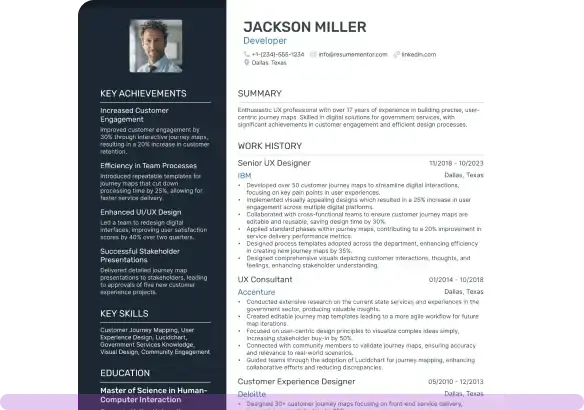Instructional Designer Resume Examples

Mar 26, 2025
|
12 min read
Craft your instructional designer resume to teach employers why you’re the best fit. Learn to design clear, concise sections that illustrate your unique skills, creativity, and professional journey in a way that truly instructs interest.
Rated by 348 people
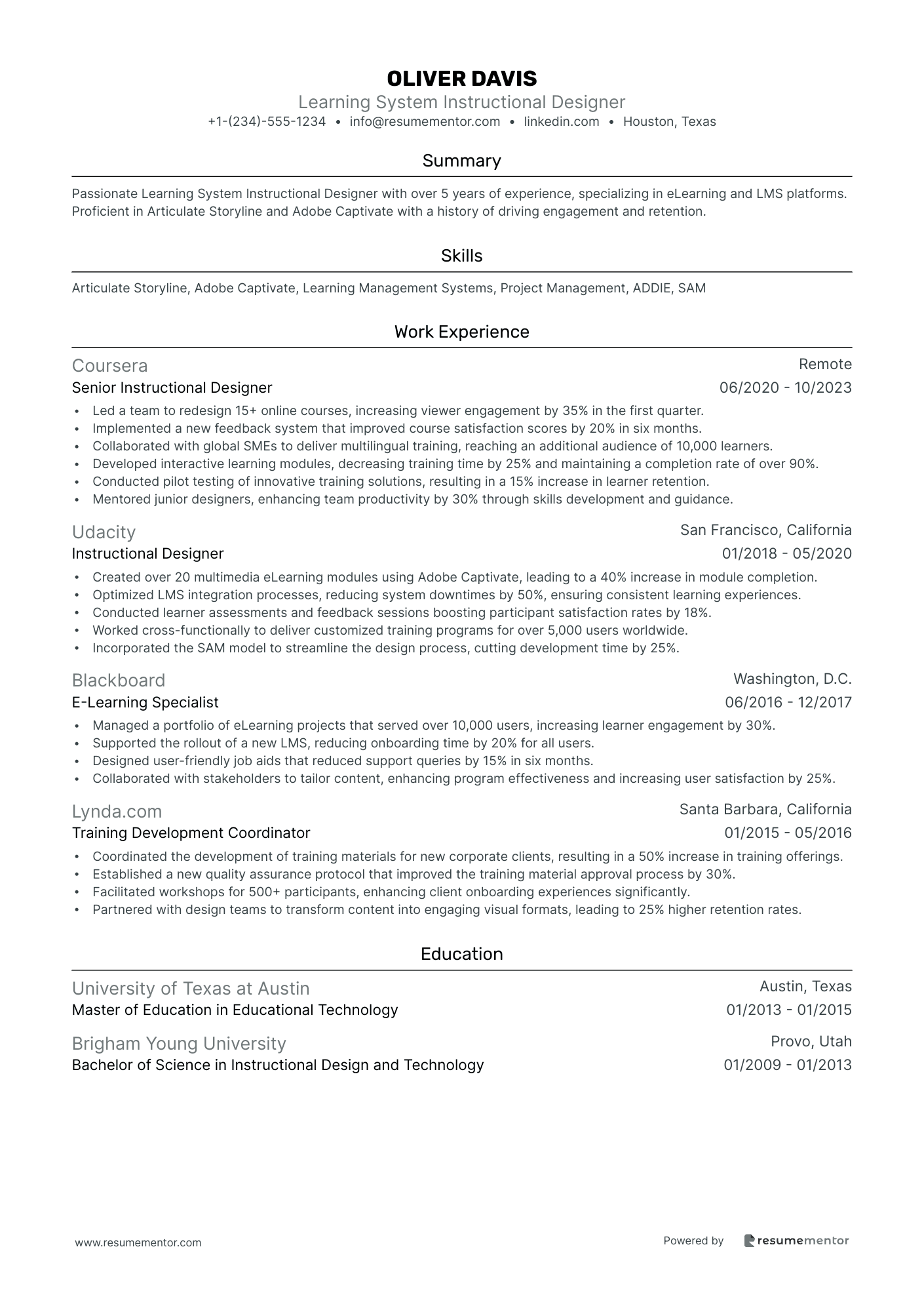
Learning System Instructional Designer

E-Learning Course Designer
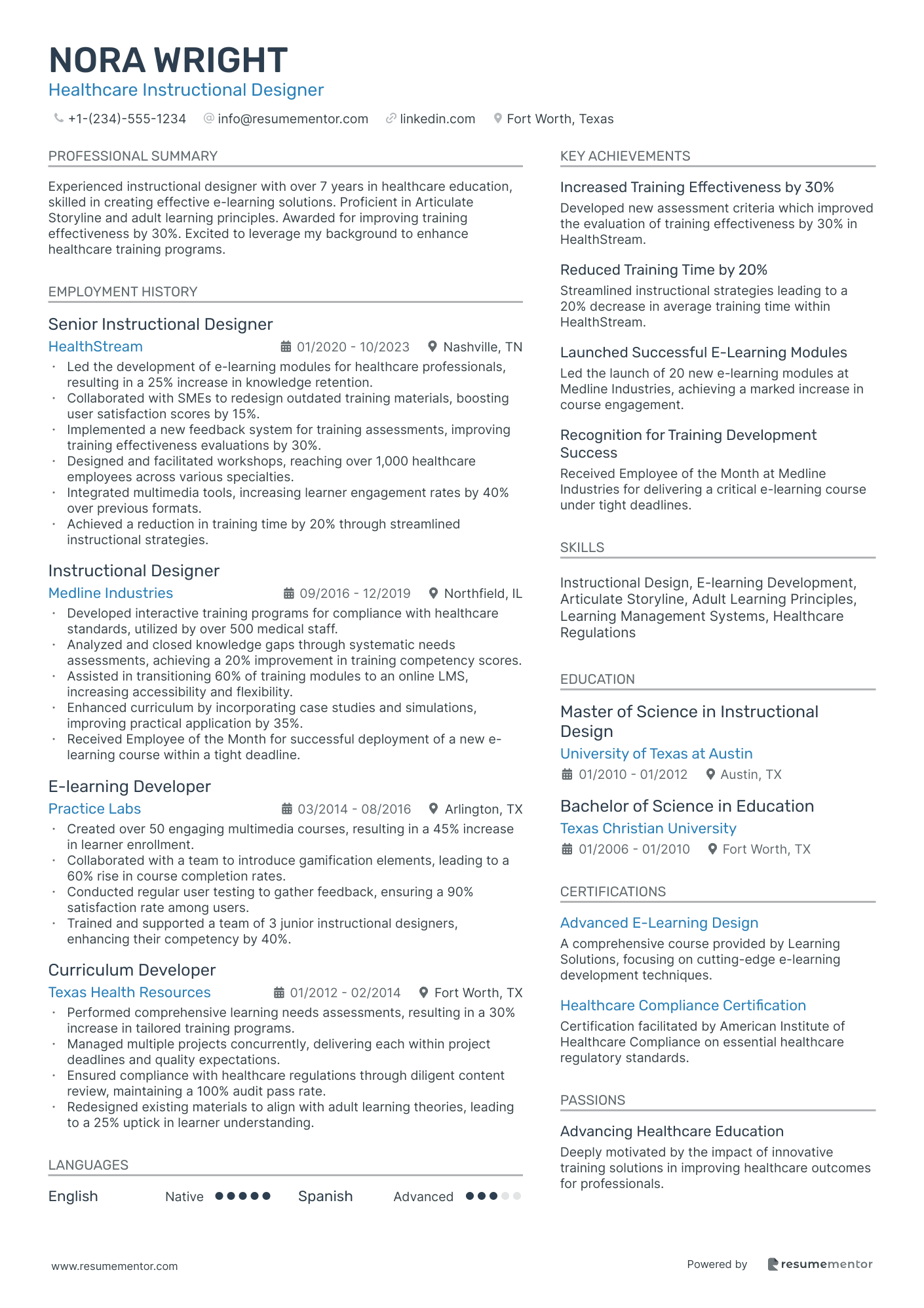
Healthcare Instructional Designer
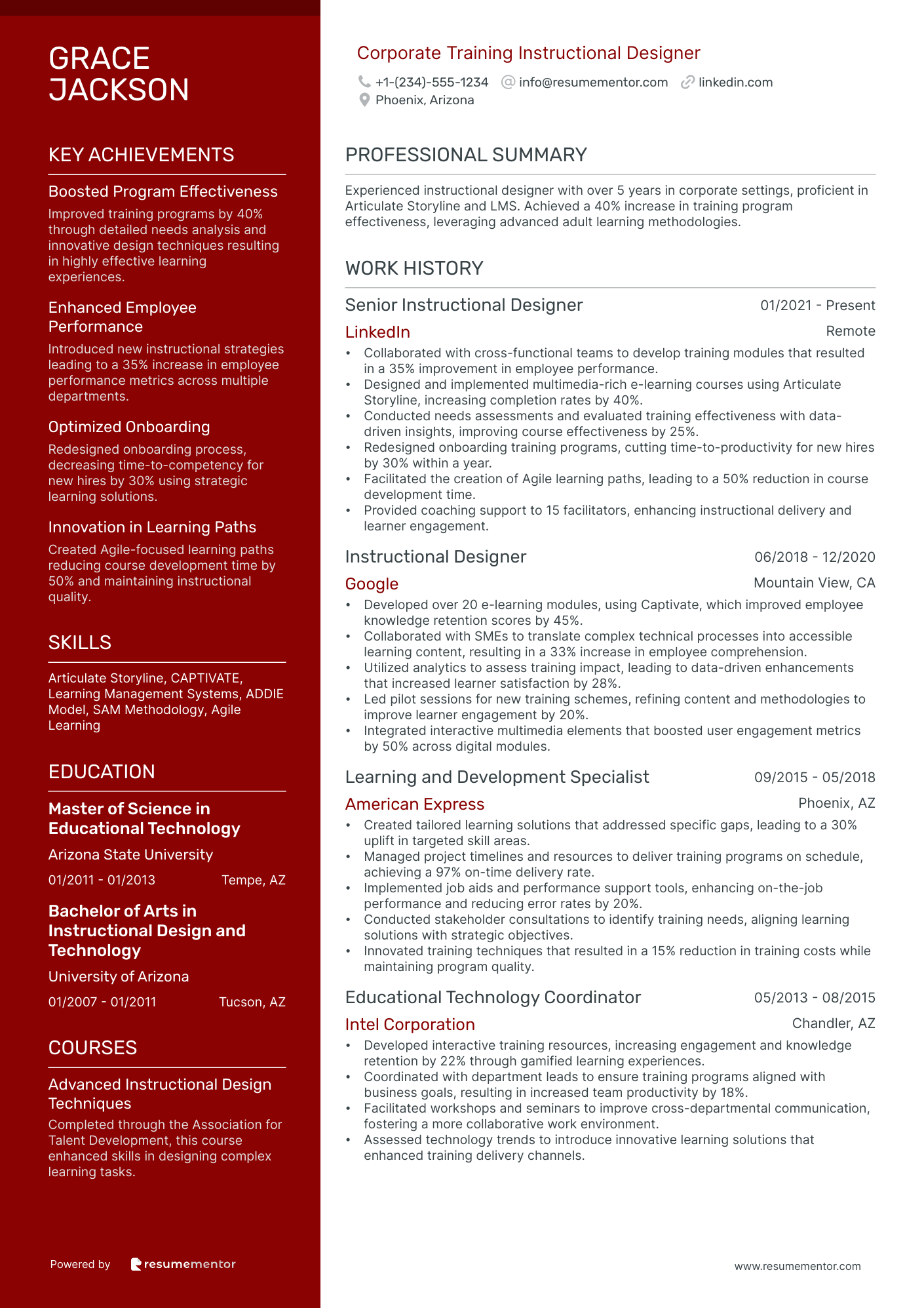
Corporate Training Instructional Designer
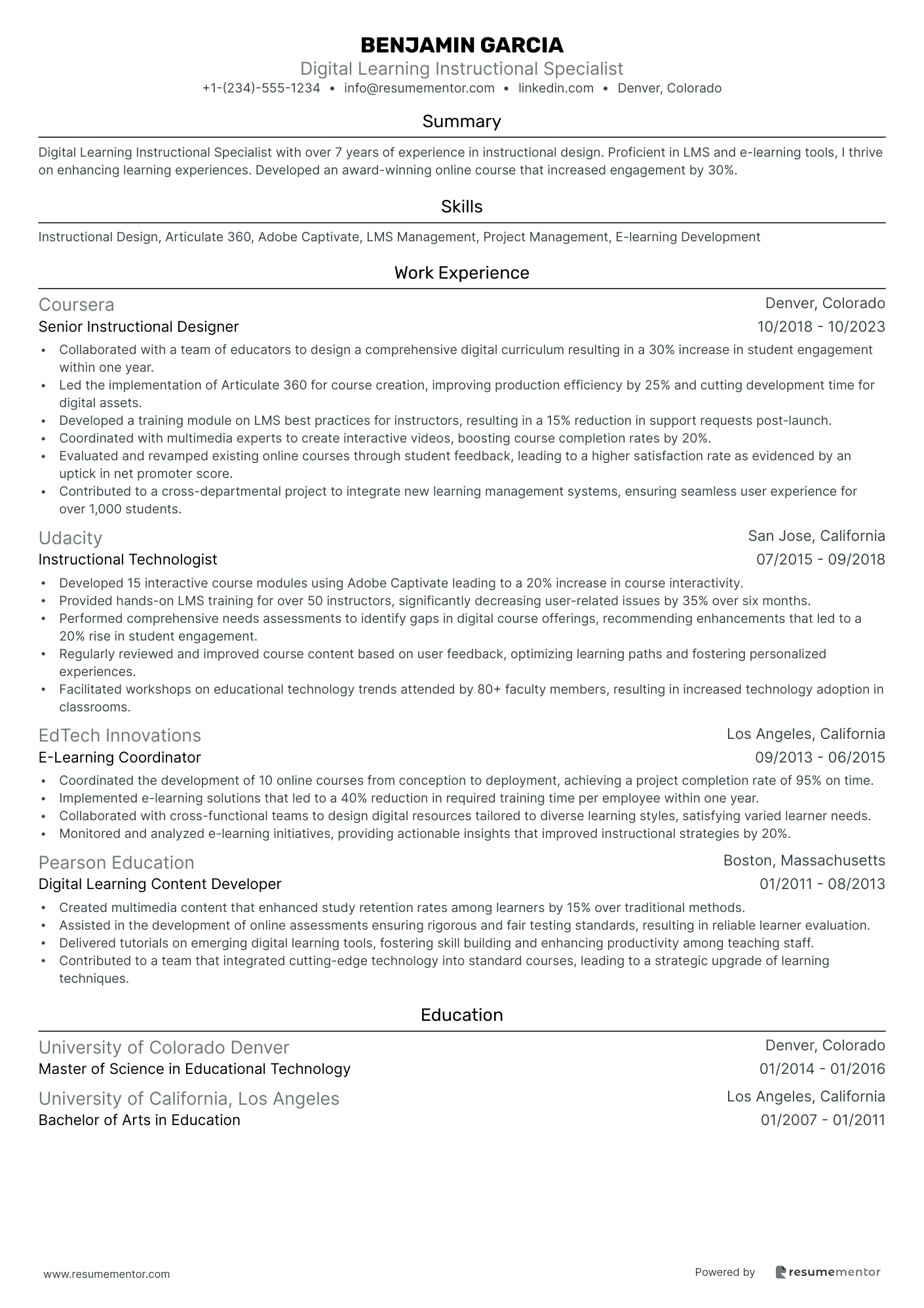
Digital Learning Instructional Specialist
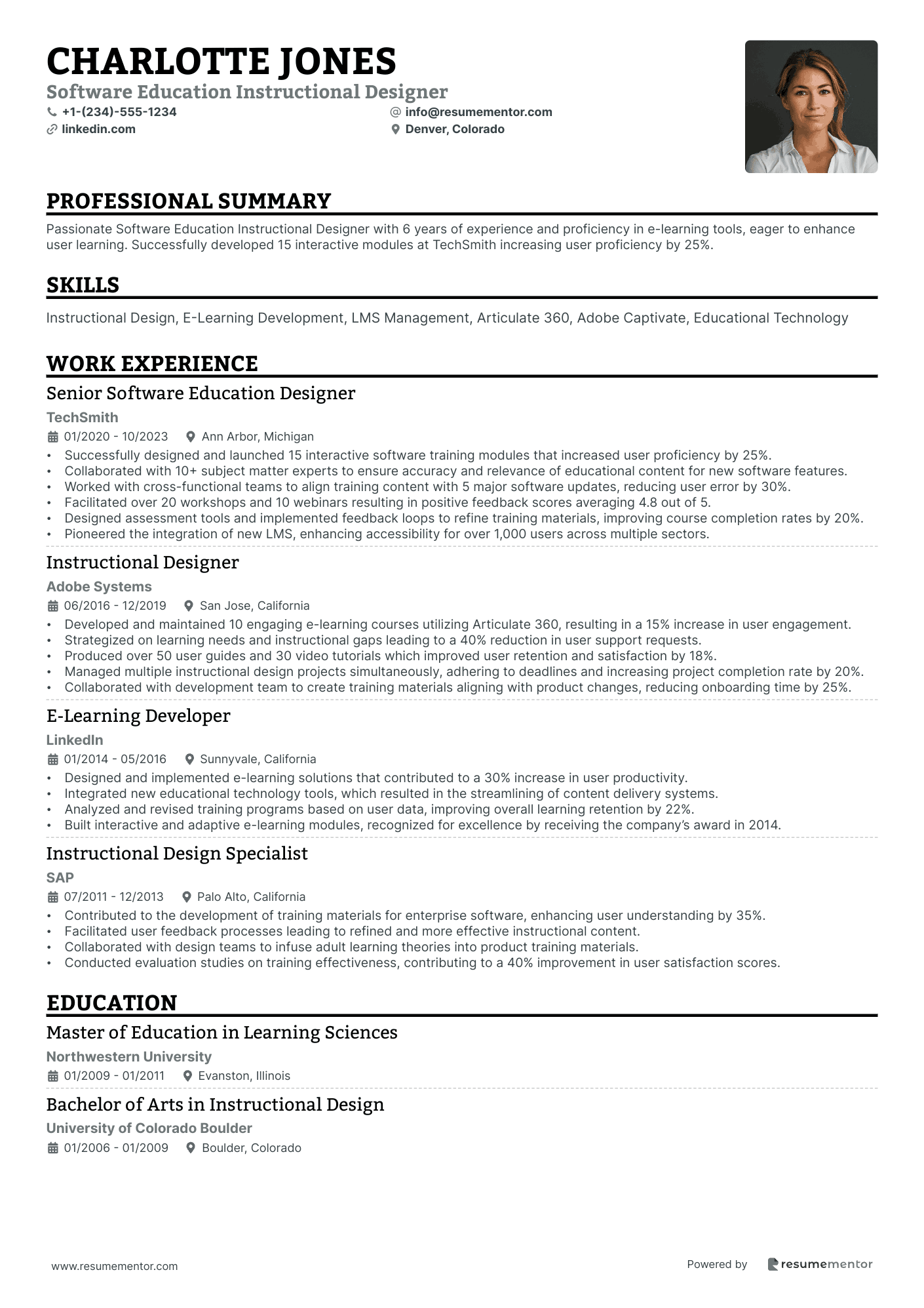
Software Education Instructional Designer
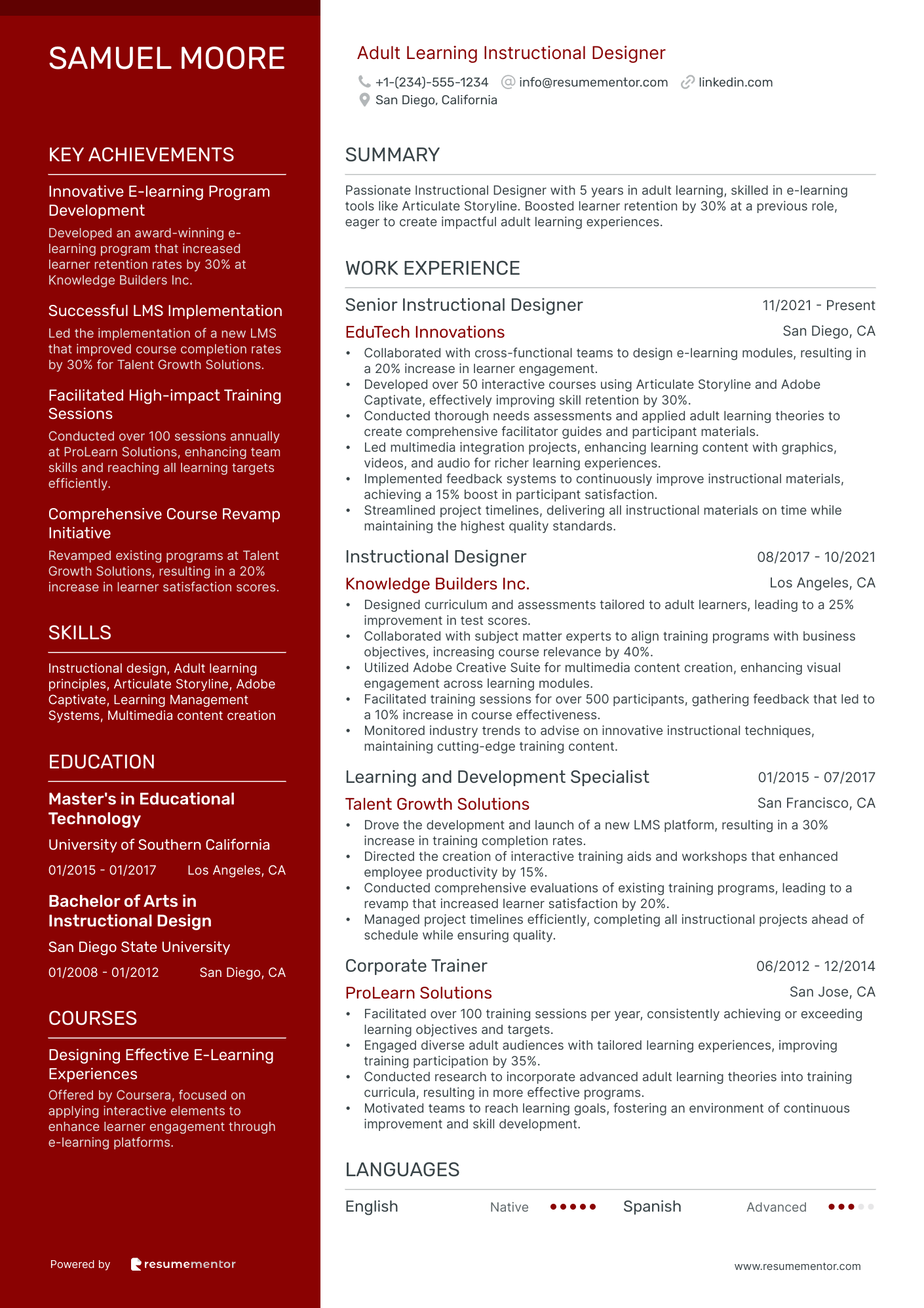
Adult Learning Instructional Designer
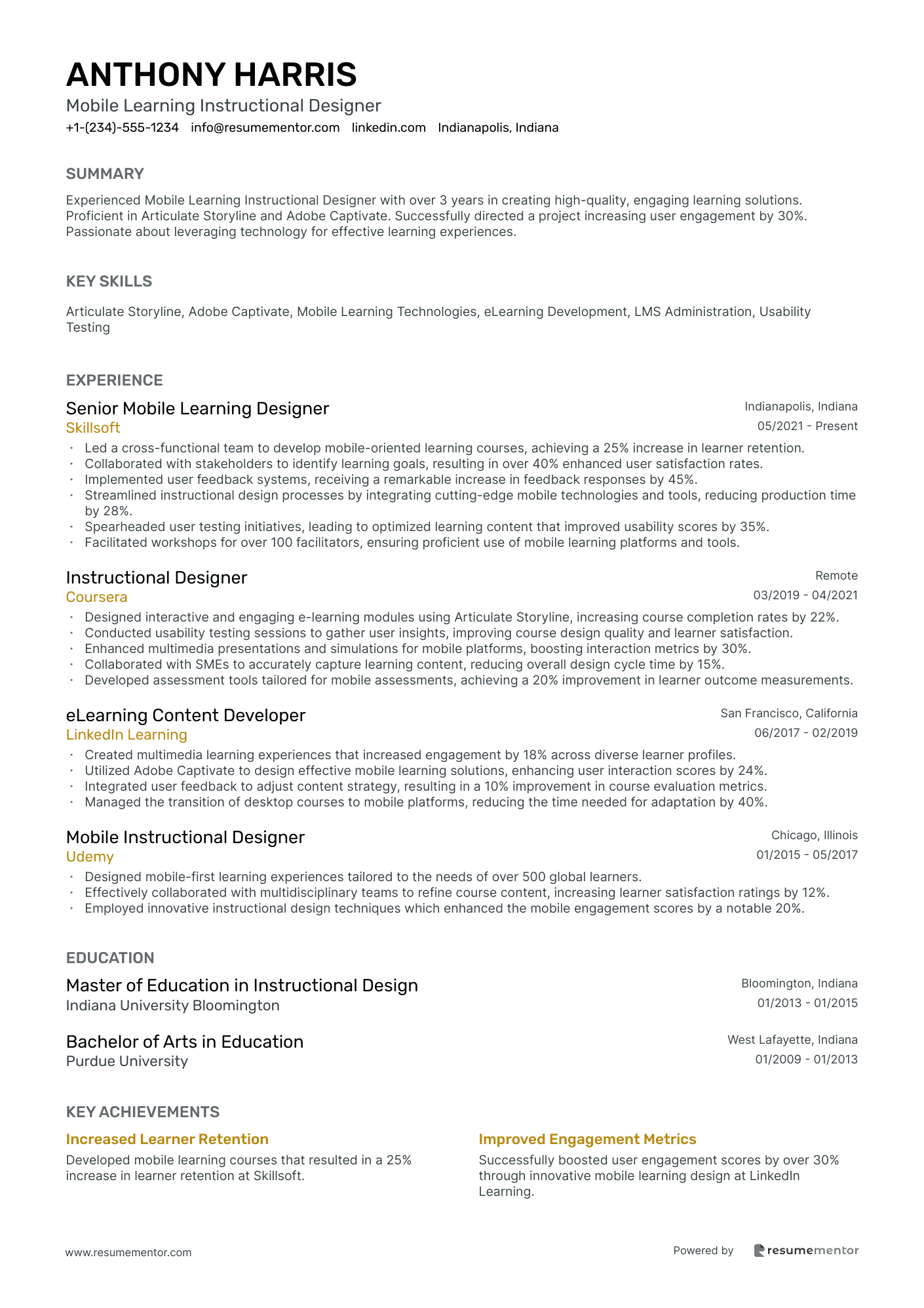
Mobile Learning Instructional Designer
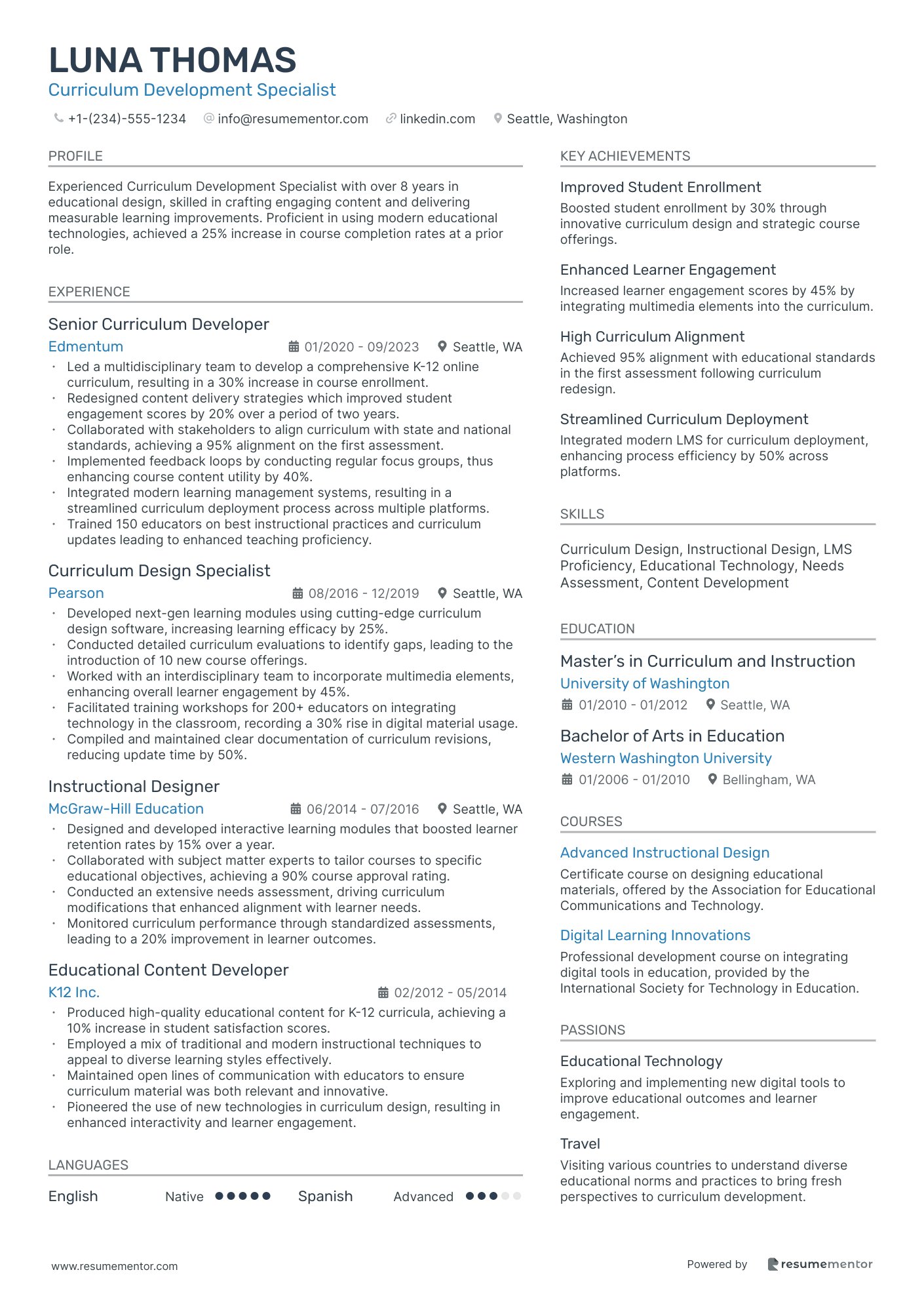
Curriculum Development Specialist
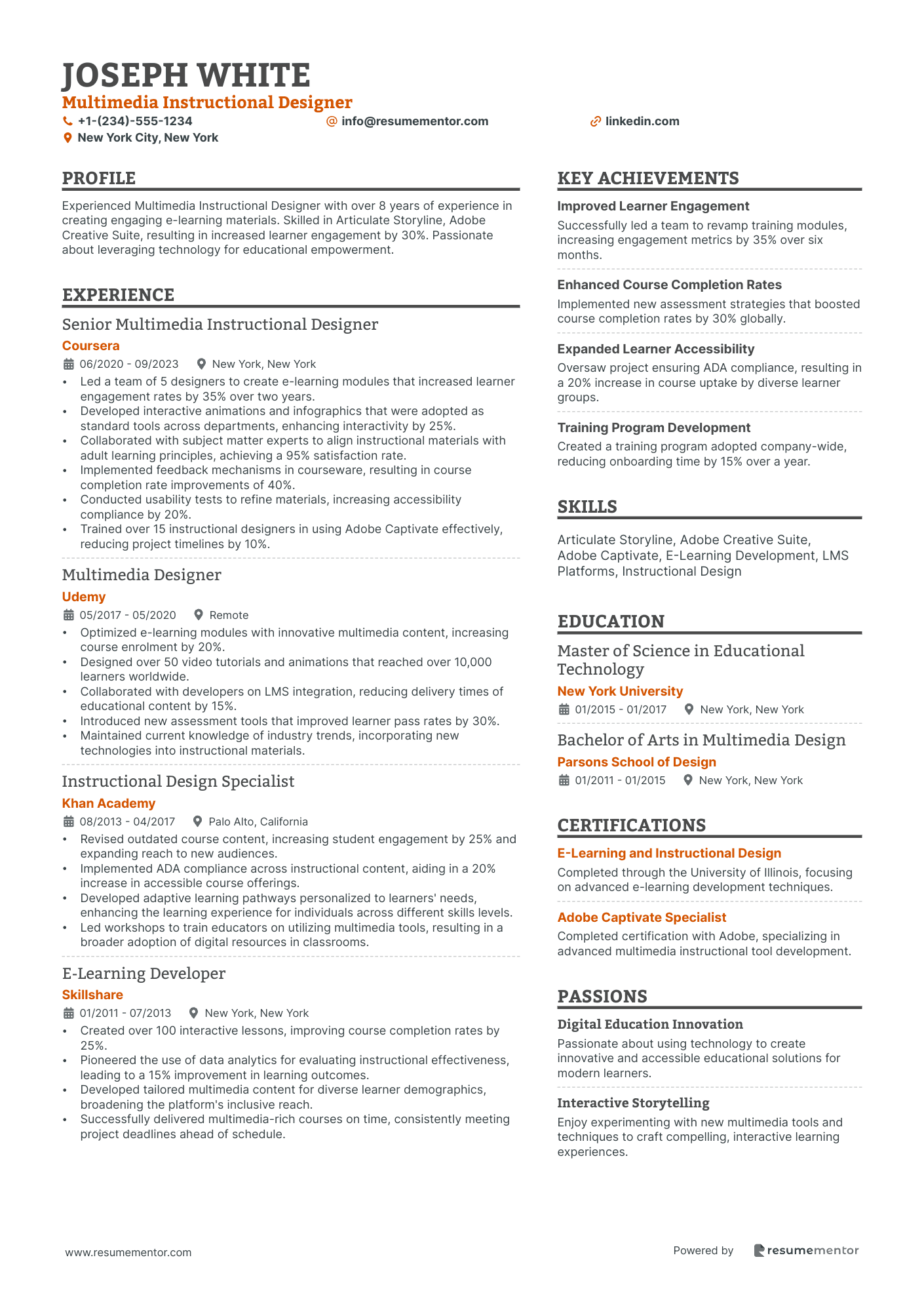
Multimedia Instructional Designer

Learning System Instructional Designer resume sample
- •Led a team to redesign 15+ online courses, increasing viewer engagement by 35% in the first quarter.
- •Implemented a new feedback system that improved course satisfaction scores by 20% in six months.
- •Collaborated with global SMEs to deliver multilingual training, reaching an additional audience of 10,000 learners.
- •Developed interactive learning modules, decreasing training time by 25% and maintaining a completion rate of over 90%.
- •Conducted pilot testing of innovative training solutions, resulting in a 15% increase in learner retention.
- •Mentored junior designers, enhancing team productivity by 30% through skills development and guidance.
- •Created over 20 multimedia eLearning modules using Adobe Captivate, leading to a 40% increase in module completion.
- •Optimized LMS integration processes, reducing system downtimes by 50%, ensuring consistent learning experiences.
- •Conducted learner assessments and feedback sessions boosting participant satisfaction rates by 18%.
- •Worked cross-functionally to deliver customized training programs for over 5,000 users worldwide.
- •Incorporated the SAM model to streamline the design process, cutting development time by 25%.
- •Managed a portfolio of eLearning projects that served over 10,000 users, increasing learner engagement by 30%.
- •Supported the rollout of a new LMS, reducing onboarding time by 20% for all users.
- •Designed user-friendly job aids that reduced support queries by 15% in six months.
- •Collaborated with stakeholders to tailor content, enhancing program effectiveness and increasing user satisfaction by 25%.
- •Coordinated the development of training materials for new corporate clients, resulting in a 50% increase in training offerings.
- •Established a new quality assurance protocol that improved the training material approval process by 30%.
- •Facilitated workshops for 500+ participants, enhancing client onboarding experiences significantly.
- •Partnered with design teams to transform content into engaging visual formats, leading to 25% higher retention rates.
E-Learning Course Designer resume sample
- •Led a team to design an interactive e-learning course program, enhancing user engagement by 40% and increasing course completion rates by 35%.
- •Utilized Articulate Storyline to develop over 30 courses, integrating multimedia elements resulting in a 25% boost in learner retention.
- •Coordinated with SMEs to revamp course objectives, aligning them with industry standards and achieving a learner satisfaction score of 92%.
- •Analyzed learner feedback and iterated course content, resulting in a 20% improvement in monthly re-enrollment rates.
- •Trained and supported 50 instructors in employing e-learning technologies, optimizing their teaching efficiency by 30%.
- •Developed instructional materials compliant with WCAG standards, expanding course accessibility by 50%.
- •Designed and implemented over 20 courses using Adobe Captivate, achieving a course satisfaction increase by 15%.
- •Collaborated with SMEs to strategize course content, which increased learner engagement metrics by 28%.
- •Produced high-quality video content for courses, reducing production time by 10% while maintaining high learner ratings.
- •Pioneered course assessments and quizzes that improved learner comprehension scores by 18% on average.
- •Conducted training workshops for faculty to facilitate better understanding and management of LMS platforms, resulting in enhanced curriculum delivery.
- •Developed instructional modules that led to a 15% increase in user enrollment and engagement over two quarters.
- •Integrated HTML/CSS features into course design improving user interface and accessibility for a broader audience.
- •Collaborated with stakeholders to ensure consistent delivery of educational content across digital platforms.
- •Authored comprehensive course guides, contributing to a significant rise in course completion rates.
- •Designed multimedia content for e-learning that increased course enrollment by 12% over three major projects.
- •Enhanced course evaluation methods, leading to a 10% in learner satisfaction scores.
- •Assisted in the development of accessible course materials in line with industry standards, broadening reach to diverse learners.
- •Provided technical support for course platforms, reducing unexpected downtimes by 20%.
Healthcare Instructional Designer resume sample
- •Led the development of e-learning modules for healthcare professionals, resulting in a 25% increase in knowledge retention.
- •Collaborated with SMEs to redesign outdated training materials, boosting user satisfaction scores by 15%.
- •Implemented a new feedback system for training assessments, improving training effectiveness evaluations by 30%.
- •Designed and facilitated workshops, reaching over 1,000 healthcare employees across various specialties.
- •Integrated multimedia tools, increasing learner engagement rates by 40% over previous formats.
- •Achieved a reduction in training time by 20% through streamlined instructional strategies.
- •Developed interactive training programs for compliance with healthcare standards, utilized by over 500 medical staff.
- •Analyzed and closed knowledge gaps through systematic needs assessments, achieving a 20% improvement in training competency scores.
- •Assisted in transitioning 60% of training modules to an online LMS, increasing accessibility and flexibility.
- •Enhanced curriculum by incorporating case studies and simulations, improving practical application by 35%.
- •Received Employee of the Month for successful deployment of a new e-learning course within a tight deadline.
- •Created over 50 engaging multimedia courses, resulting in a 45% increase in learner enrollment.
- •Collaborated with a team to introduce gamification elements, leading to a 60% rise in course completion rates.
- •Conducted regular user testing to gather feedback, ensuring a 90% satisfaction rate among users.
- •Trained and supported a team of 3 junior instructional designers, enhancing their competency by 40%.
- •Performed comprehensive learning needs assessments, resulting in a 30% increase in tailored training programs.
- •Managed multiple projects concurrently, delivering each within project deadlines and quality expectations.
- •Ensured compliance with healthcare regulations through diligent content review, maintaining a 100% audit pass rate.
- •Redesigned existing materials to align with adult learning theories, leading to a 25% uptick in learner understanding.
Corporate Training Instructional Designer resume sample
- •Collaborated with cross-functional teams to develop training modules that resulted in a 35% improvement in employee performance.
- •Designed and implemented multimedia-rich e-learning courses using Articulate Storyline, increasing completion rates by 40%.
- •Conducted needs assessments and evaluated training effectiveness with data-driven insights, improving course effectiveness by 25%.
- •Redesigned onboarding training programs, cutting time-to-productivity for new hires by 30% within a year.
- •Facilitated the creation of Agile learning paths, leading to a 50% reduction in course development time.
- •Provided coaching support to 15 facilitators, enhancing instructional delivery and learner engagement.
- •Developed over 20 e-learning modules, using Captivate, which improved employee knowledge retention scores by 45%.
- •Collaborated with SMEs to translate complex technical processes into accessible learning content, resulting in a 33% increase in employee comprehension.
- •Utilized analytics to assess training impact, leading to data-driven enhancements that increased learner satisfaction by 28%.
- •Led pilot sessions for new training schemes, refining content and methodologies to improve learner engagement by 20%.
- •Integrated interactive multimedia elements that boosted user engagement metrics by 50% across digital modules.
- •Created tailored learning solutions that addressed specific gaps, leading to a 30% uplift in targeted skill areas.
- •Managed project timelines and resources to deliver training programs on schedule, achieving a 97% on-time delivery rate.
- •Implemented job aids and performance support tools, enhancing on-the-job performance and reducing error rates by 20%.
- •Conducted stakeholder consultations to identify training needs, aligning learning solutions with strategic objectives.
- •Innovated training techniques that resulted in a 15% reduction in training costs while maintaining program quality.
- •Developed interactive training resources, increasing engagement and knowledge retention by 22% through gamified learning experiences.
- •Coordinated with department leads to ensure training programs aligned with business goals, resulting in increased team productivity by 18%.
- •Facilitated workshops and seminars to improve cross-departmental communication, fostering a more collaborative work environment.
- •Assessed technology trends to introduce innovative learning solutions that enhanced training delivery channels.
Digital Learning Instructional Specialist resume sample
- •Collaborated with a team of educators to design a comprehensive digital curriculum resulting in a 30% increase in student engagement within one year.
- •Led the implementation of Articulate 360 for course creation, improving production efficiency by 25% and cutting development time for digital assets.
- •Developed a training module on LMS best practices for instructors, resulting in a 15% reduction in support requests post-launch.
- •Coordinated with multimedia experts to create interactive videos, boosting course completion rates by 20%.
- •Evaluated and revamped existing online courses through student feedback, leading to a higher satisfaction rate as evidenced by an uptick in net promoter score.
- •Contributed to a cross-departmental project to integrate new learning management systems, ensuring seamless user experience for over 1,000 students.
- •Developed 15 interactive course modules using Adobe Captivate leading to a 20% increase in course interactivity.
- •Provided hands-on LMS training for over 50 instructors, significantly decreasing user-related issues by 35% over six months.
- •Performed comprehensive needs assessments to identify gaps in digital course offerings, recommending enhancements that led to a 20% rise in student engagement.
- •Regularly reviewed and improved course content based on user feedback, optimizing learning paths and fostering personalized experiences.
- •Facilitated workshops on educational technology trends attended by 80+ faculty members, resulting in increased technology adoption in classrooms.
- •Coordinated the development of 10 online courses from conception to deployment, achieving a project completion rate of 95% on time.
- •Implemented e-learning solutions that led to a 40% reduction in required training time per employee within one year.
- •Collaborated with cross-functional teams to design digital resources tailored to diverse learning styles, satisfying varied learner needs.
- •Monitored and analyzed e-learning initiatives, providing actionable insights that improved instructional strategies by 20%.
- •Created multimedia content that enhanced study retention rates among learners by 15% over traditional methods.
- •Assisted in the development of online assessments ensuring rigorous and fair testing standards, resulting in reliable learner evaluation.
- •Delivered tutorials on emerging digital learning tools, fostering skill building and enhancing productivity among teaching staff.
- •Contributed to a team that integrated cutting-edge technology into standard courses, leading to a strategic upgrade of learning techniques.
Software Education Instructional Designer resume sample
- •Successfully designed and launched 15 interactive software training modules that increased user proficiency by 25%.
- •Collaborated with 10+ subject matter experts to ensure accuracy and relevance of educational content for new software features.
- •Worked with cross-functional teams to align training content with 5 major software updates, reducing user error by 30%.
- •Facilitated over 20 workshops and 10 webinars resulting in positive feedback scores averaging 4.8 out of 5.
- •Designed assessment tools and implemented feedback loops to refine training materials, improving course completion rates by 20%.
- •Pioneered the integration of new LMS, enhancing accessibility for over 1,000 users across multiple sectors.
- •Developed and maintained 10 engaging e-learning courses utilizing Articulate 360, resulting in a 15% increase in user engagement.
- •Strategized on learning needs and instructional gaps leading to a 40% reduction in user support requests.
- •Produced over 50 user guides and 30 video tutorials which improved user retention and satisfaction by 18%.
- •Managed multiple instructional design projects simultaneously, adhering to deadlines and increasing project completion rate by 20%.
- •Collaborated with development team to create training materials aligning with product changes, reducing onboarding time by 25%.
- •Designed and implemented e-learning solutions that contributed to a 30% increase in user productivity.
- •Integrated new educational technology tools, which resulted in the streamlining of content delivery systems.
- •Analyzed and revised training programs based on user data, improving overall learning retention by 22%.
- •Built interactive and adaptive e-learning modules, recognized for excellence by receiving the company’s award in 2014.
- •Contributed to the development of training materials for enterprise software, enhancing user understanding by 35%.
- •Facilitated user feedback processes leading to refined and more effective instructional content.
- •Collaborated with design teams to infuse adult learning theories into product training materials.
- •Conducted evaluation studies on training effectiveness, contributing to a 40% improvement in user satisfaction scores.
Adult Learning Instructional Designer resume sample
- •Collaborated with cross-functional teams to design e-learning modules, resulting in a 20% increase in learner engagement.
- •Developed over 50 interactive courses using Articulate Storyline and Adobe Captivate, effectively improving skill retention by 30%.
- •Conducted thorough needs assessments and applied adult learning theories to create comprehensive facilitator guides and participant materials.
- •Led multimedia integration projects, enhancing learning content with graphics, videos, and audio for richer learning experiences.
- •Implemented feedback systems to continuously improve instructional materials, achieving a 15% boost in participant satisfaction.
- •Streamlined project timelines, delivering all instructional materials on time while maintaining the highest quality standards.
- •Designed curriculum and assessments tailored to adult learners, leading to a 25% improvement in test scores.
- •Collaborated with subject matter experts to align training programs with business objectives, increasing course relevance by 40%.
- •Utilized Adobe Creative Suite for multimedia content creation, enhancing visual engagement across learning modules.
- •Facilitated training sessions for over 500 participants, gathering feedback that led to a 10% increase in course effectiveness.
- •Monitored industry trends to advise on innovative instructional techniques, maintaining cutting-edge training content.
- •Drove the development and launch of a new LMS platform, resulting in a 30% increase in training completion rates.
- •Directed the creation of interactive training aids and workshops that enhanced employee productivity by 15%.
- •Conducted comprehensive evaluations of existing training programs, leading to a revamp that increased learner satisfaction by 20%.
- •Managed project timelines efficiently, completing all instructional projects ahead of schedule while ensuring quality.
- •Facilitated over 100 training sessions per year, consistently achieving or exceeding learning objectives and targets.
- •Engaged diverse adult audiences with tailored learning experiences, improving training participation by 35%.
- •Conducted research to incorporate advanced adult learning theories into training curricula, resulting in more effective programs.
- •Motivated teams to reach learning goals, fostering an environment of continuous improvement and skill development.
Mobile Learning Instructional Designer resume sample
- •Led a cross-functional team to develop mobile-oriented learning courses, achieving a 25% increase in learner retention.
- •Collaborated with stakeholders to identify learning goals, resulting in over 40% enhanced user satisfaction rates.
- •Implemented user feedback systems, receiving a remarkable increase in feedback responses by 45%.
- •Streamlined instructional design processes by integrating cutting-edge mobile technologies and tools, reducing production time by 28%.
- •Spearheaded user testing initiatives, leading to optimized learning content that improved usability scores by 35%.
- •Facilitated workshops for over 100 facilitators, ensuring proficient use of mobile learning platforms and tools.
- •Designed interactive and engaging e-learning modules using Articulate Storyline, increasing course completion rates by 22%.
- •Conducted usability testing sessions to gather user insights, improving course design quality and learner satisfaction.
- •Enhanced multimedia presentations and simulations for mobile platforms, boosting interaction metrics by 30%.
- •Collaborated with SMEs to accurately capture learning content, reducing overall design cycle time by 15%.
- •Developed assessment tools tailored for mobile assessments, achieving a 20% improvement in learner outcome measurements.
- •Created multimedia learning experiences that increased engagement by 18% across diverse learner profiles.
- •Utilized Adobe Captivate to design effective mobile learning solutions, enhancing user interaction scores by 24%.
- •Integrated user feedback to adjust content strategy, resulting in a 10% improvement in course evaluation metrics.
- •Managed the transition of desktop courses to mobile platforms, reducing the time needed for adaptation by 40%.
- •Designed mobile-first learning experiences tailored to the needs of over 500 global learners.
- •Effectively collaborated with multidisciplinary teams to refine course content, increasing learner satisfaction ratings by 12%.
- •Employed innovative instructional design techniques which enhanced the mobile engagement scores by a notable 20%.
Curriculum Development Specialist resume sample
- •Led a multidisciplinary team to develop a comprehensive K-12 online curriculum, resulting in a 30% increase in course enrollment.
- •Redesigned content delivery strategies which improved student engagement scores by 20% over a period of two years.
- •Collaborated with stakeholders to align curriculum with state and national standards, achieving a 95% alignment on the first assessment.
- •Implemented feedback loops by conducting regular focus groups, thus enhancing course content utility by 40%.
- •Integrated modern learning management systems, resulting in a streamlined curriculum deployment process across multiple platforms.
- •Trained 150 educators on best instructional practices and curriculum updates leading to enhanced teaching proficiency.
- •Developed next-gen learning modules using cutting-edge curriculum design software, increasing learning efficacy by 25%.
- •Conducted detailed curriculum evaluations to identify gaps, leading to the introduction of 10 new course offerings.
- •Worked with an interdisciplinary team to incorporate multimedia elements, enhancing overall learner engagement by 45%.
- •Facilitated training workshops for 200+ educators on integrating technology in the classroom, recording a 30% rise in digital material usage.
- •Compiled and maintained clear documentation of curriculum revisions, reducing update time by 50%.
- •Designed and developed interactive learning modules that boosted learner retention rates by 15% over a year.
- •Collaborated with subject matter experts to tailor courses to specific educational objectives, achieving a 90% course approval rating.
- •Conducted an extensive needs assessment, driving curriculum modifications that enhanced alignment with learner needs.
- •Monitored curriculum performance through standardized assessments, leading to a 20% improvement in learner outcomes.
- •Produced high-quality educational content for K-12 curricula, achieving a 10% increase in student satisfaction scores.
- •Employed a mix of traditional and modern instructional techniques to appeal to diverse learning styles effectively.
- •Maintained open lines of communication with educators to ensure curriculum material was both relevant and innovative.
- •Pioneered the use of new technologies in curriculum design, resulting in enhanced interactivity and learner engagement.
Multimedia Instructional Designer resume sample
- •Led a team of 5 designers to create e-learning modules that increased learner engagement rates by 35% over two years.
- •Developed interactive animations and infographics that were adopted as standard tools across departments, enhancing interactivity by 25%.
- •Collaborated with subject matter experts to align instructional materials with adult learning principles, achieving a 95% satisfaction rate.
- •Implemented feedback mechanisms in courseware, resulting in course completion rate improvements of 40%.
- •Conducted usability tests to refine materials, increasing accessibility compliance by 20%.
- •Trained over 15 instructional designers in using Adobe Captivate effectively, reducing project timelines by 10%.
- •Optimized e-learning modules with innovative multimedia content, increasing course enrolment by 20%.
- •Designed over 50 video tutorials and animations that reached over 10,000 learners worldwide.
- •Collaborated with developers on LMS integration, reducing delivery times of educational content by 15%.
- •Introduced new assessment tools that improved learner pass rates by 30%.
- •Maintained current knowledge of industry trends, incorporating new technologies into instructional materials.
- •Revised outdated course content, increasing student engagement by 25% and expanding reach to new audiences.
- •Implemented ADA compliance across instructional content, aiding in a 20% increase in accessible course offerings.
- •Developed adaptive learning pathways personalized to learners' needs, enhancing the learning experience for individuals across different skills levels.
- •Led workshops to train educators on utilizing multimedia tools, resulting in a broader adoption of digital resources in classrooms.
- •Created over 100 interactive lessons, improving course completion rates by 25%.
- •Pioneered the use of data analytics for evaluating instructional effectiveness, leading to a 15% improvement in learning outcomes.
- •Developed tailored multimedia content for diverse learner demographics, broadening the platform's inclusive reach.
- •Successfully delivered multimedia-rich courses on time, consistently meeting project deadlines ahead of schedule.
As an instructional designer, you're the architect of learning experiences, shaping educational journeys with creativity and precision. Yet, translating this into your resume can be challenging, as capturing such depth and scope on paper can feel daunting. The hiring landscape often resembles a complex puzzle, where presenting your skills in curriculum design and digital technology becomes a crucial task.
This is where finding the right flow and format becomes essential. A resume that blends creativity with a clear demonstration of your instructional design expertise is vital. Using a resume template designed for broad career fields can provide a solid foundation. These templates help you focus on content rather than getting caught up in formatting details. Exploring resume templates crafted for general use is a smart place to begin, as they can guide your presentation.
As you draft your resume, aim for each line to reflect how you've transformed learning environments into spaces that engage and adapt to evolving needs. This requires striking a balance between detailing your achievements and maintaining concise presentation.
Ultimately, your resume is more than a list of jobs—it's a narrative showcasing how you bring innovation and technology into education, creating dynamic and effective learning experiences. Approach this process as an opportunity to demonstrate how you've turned educational challenges into pathways for growth and success.
Key Takeaways
- To create an effective instructional designer resume, it is essential to highlight your expertise in instructional design methodologies and e-learning technologies while balancing your achievements and concise presentation.
- Leveraging a resume template designed for broad career fields can help focus on content and guide the presentation while ensuring clarity and creativity.
- Structuring your resume with sections such as contact information, professional summary, skills, work experience, education, and technical proficiency is crucial for showcasing your abilities effectively.
- Quantifiable achievements and action verbs should be used to illustrate the results and impact of your work in the work experience section.
- Extra sections such as languages, hobbies, volunteer work, and books can provide unique insights to potential employers, enhancing your resume’s richness and helping it stand out.
What to focus on when writing your instructional designer resume
An instructional designer resume should effectively convey your expertise in creating engaging educational content. Demonstrating your skills in instructional design methodologies and e-learning technologies is key to showcasing your strengths.
How to structure your instructional designer resume
- Contact Information: Make sure your full name, phone number, email address, and LinkedIn profile are easy for recruiters to find, allowing them to contact you without hassle. Use a professional email address that reflects your name. Including a LinkedIn profile adds a layer of professionalism and provides recruiters with additional insights into your career journey—let's delve further into how each section ties together to form a cohesive resume.
- Professional Summary: Capture your career in instructional design with a concise paragraph that uses impactful terms like “e-learning solutions” and “curriculum development” to set the tone for your resume. Tailor this summary to reflect specific experiences aligned with the job you’re applying for, and keep it focused on what you offer as a candidate—it provides a snapshot of your career we’ll expand upon below.
- Skills: Highlight specialized skills such as “storyboarding,” “LMS proficiency,” and “knowledge of ADDIE model,” which are essential for showcasing your capability in instructional design. Concentrate on skills that are frequently requested in job postings to ensure relevance. Prioritize hard skills over soft skills for impact—we'll explore how to align skills effectively in your resume format.
- Work Experience: Build on your skills by detailing your past roles in instructional design or related fields. Use action verbs and quantifiable achievements, like “Increased course completion rates by 20%,” to demonstrate your ability to deliver results. Be specific about your contributions in past positions to illustrate your results-oriented approach—our next overview will unpack structuring this section for maximum impact.
- Education: Reinforce your experience with your degrees and any relevant certifications, such as “Master’s in Instructional Design” or “Certified Professional in Learning and Performance (CPLP),” which underscore your commitment to the field. List education in reverse chronological order to highlight recent accomplishments and relevant coursework that supports your career objectives—you'll see how this integrates with other sections shortly.
- Technical Proficiency: Complement your education and experience with proficiency in tools like Articulate Storyline, Adobe Captivate, or Camtasia, and mention your familiarity with Learning Management Systems (LMS) to round out your technical skill set. This section is crucial for highlighting your hands-on ability with relevant software and technology, reflecting the industry standards—a structured view will follow on how these tools enhance your resume's appeal.
For added depth, you can include optional sections like “Professional Affiliations” or “Volunteer Experience” to showcase your involvement and passion for the instructional design industry. Let's now explore each section more in-depth to understand the ideal format for an instructional designer resume.
Which resume format to choose
For an instructional designer, choosing the right resume format is essential to effectively present your qualifications. The combination format is particularly useful, as it balances the chronological and functional styles. This format allows you to map out your career path while spotlighting the instructional design skills you bring to the table, making it easier for employers to see your value.
Selecting the right font can also subtly enhance your resume's impact. Opt for modern fonts like Rubik, Lato, or Montserrat, which are clean and professional. These fonts convey a contemporary and innovative feel, perfectly aligning with the cutting-edge nature of instructional design.
Consistency across different platforms is key, so always save your resume as a PDF. This choice keeps your formatting intact and ensures that your resume appears polished and professional, no matter where or how it’s viewed.
Pay attention to the layout with appropriate margins, typically around one inch on all sides. This spacing ensures your resume maintains a clean and organized look, reflecting your ability to convey information clearly—a vital skill in instructional design.
By integrating these elements, your resume will effectively communicate your expertise and suitability for roles in instructional design, meeting industry expectations and making a strong impression.
How to write a quantifiable resume experience section
Crafting a compelling instructional designer resume experience section can significantly enhance your appeal to potential employers. Begin by showcasing your skills and achievements, emphasizing your ability to create effective learning materials. Structure each role with details like position, company, location, and employment dates, starting from your most recent job and working backward. Choose roles that align closely with the job you're applying for. Using strong action words like "designed," "implemented," and "analyzed" helps highlight your proactive approach. Here’s how all these aspects come together in an example:
- •Designed and implemented e-learning modules that boosted learner engagement by 40%.
- •Worked with experts to craft a training program, cutting onboarding time by 20%.
- •Improved course content based on feedback, achieving a 95% satisfaction rate.
- •Led a team to create simulations, increasing course completion rates by 30%.
This experience section is effective because it ties your skills to tangible results, demonstrating a clear impact on learning engagement and efficiency. Each bullet point seamlessly connects your proactive efforts with measurable achievements, painting a cohesive picture of your professional contributions. The use of strategic action words reinforces your leadership qualities and initiative. Tailoring your experience to the job's requirements enhances relevance, making it straightforward for hiring managers to envision the value you can bring to their team. This interconnected presentation ensures each detail builds upon the last, forming a comprehensive view of your accomplishments.
Skills-Focused resume experience section
A skills-focused instructional designer resume experience section should effectively showcase the skills you've applied and the impact of your work. Start by identifying the essential skills for the role, such as curriculum development, e-learning tools, and project management, and then highlight experiences where you used these skills in meaningful ways. Using bullet points, detail how your contributions led to designing engaging educational content that drove positive learning outcomes.
Craft your bullet points by focusing on measurable successes and specific duties that underscore your proficiency. Clearly describe your accomplishments, emphasizing the direct benefits to learners or your organization. Avoid being too general; instead, spotlight your results and innovations which illustrate your adaptability to various instructional design tasks. Employers are interested in candidates who can bring immediate value, and this format helps demonstrate your potential and expertise effectively.
Instructional Designer
Tech Educate Co
June 2020 - Present
- Developed over 20 engaging online courses, boosting student engagement by 30%.
- Worked with SMEs to ensure content accuracy and relevance.
- Added interactive modules and assessments, enhancing learner retention by 25%.
- Used Asana to manage projects, ensuring on-time completion and delivery.
Collaboration-Focused resume experience section
A collaboration-focused instructional designer resume experience section should clearly demonstrate your ability to work well with others and the positive impact of your teamwork. Begin by identifying roles where collaboration played a key role in the success of projects. Reflect on how your cooperation with colleagues helped create educational materials that met the organization's goals. This will illustrate how you played an essential role in fostering effective communication and idea exchange among team members.
Organize your experience by including your job title, the organization, and employment dates, then use bullet points to detail your collaborative achievements. Ensure these points highlight instances of collective efforts, such as designing learning materials with a team, participating in cross-departmental projects, or leading meetings to gather diverse input. This detailed approach effectively underscores your collaborative skills while maintaining a clear and engaging narrative.
Instructional Designer
Global Learning Solutions
June 2021 - Present
- Led a cross-functional team to develop a comprehensive e-learning course that increased user engagement by 30%.
- Facilitated weekly meetings with subject matter experts to ensure alignment on course objectives and content accuracy.
- Collaborated with graphic designers and developers to create interactive learning modules.
- Organized training sessions for team members to enhance their understanding of instructional design practices.
Project-Focused resume experience section
A project-focused instructional designer resume experience section should highlight your ability to create engaging learning materials through specific projects rather than merely listing job titles. Concentrate on key projects that showcase your skills and the impact of your work. Use straightforward language to depict how you brought value and achieved quantifiable results. By aligning these experiences with the skills and qualifications noted in the job description, you more effectively convey how your abilities meet the employer’s needs.
When organizing your project-focused experience, ensure a clear presentation of your contributions. Start each entry with the project title and a brief description if needed, then detail your responsibilities, skills used, and outcomes through bullet points. Use action verbs in each bullet to convey initiative and results clearly. This approach not only emphasizes your accomplishments but also enables employers to readily understand how you can contribute to their organization.
Instructional Designer
XYZ Learning Solutions
June 2022 - Present
- Developed over 50 interactive online training modules for employee onboarding.
- Collaborated with subject matter experts to ensure content accuracy and relevance.
- Improved user engagement by 20% through feedback-based enhancements.
- Designed visually appealing courses using Articulate Storyline and Adobe Captivate.
Industry-Specific Focus resume experience section
A focused instructional designer resume experience section should clearly highlight your specific expertise and contributions. Start by identifying your area of focus, whether it's curriculum development, e-learning design, or blended learning solutions. Describe how you've used your skills and technology to enhance educational experiences, which paints a picture of your role in improving outcomes. Collaboration with educators or subject matter experts is key, so emphasize these partnerships alongside your proficiency with instructional design tools or software, showcasing your ability to meet diverse learner needs.
When detailing your experience, it's important to concentrate on your achievements and the impact you've made, rather than just listing duties. Use action verbs and quantify your results to provide a solid understanding of your accomplishments. Explain how your efforts have led to better learning outcomes or increased efficiency, making it evident to employers that you are proactive, results-focused, and adaptable to varied educational settings. A well-crafted narrative effectively communicates how your skills have played a significant role in your organization's success.
Instructional Designer
TechEd Solutions
June 2020 - Present
- Designed and developed over 50 online courses resulting in a 30% increase in student engagement.
- Collaborated with subject matter experts to create interactive modules tailored to varied learning styles.
- Utilized Articulate Storyline and Adobe Captivate, enhancing the visual and interactive aspects of course content.
- Improved the assessment process by integrating formative assessments that boosted course completion rates by 20%.
Write your instructional designer resume summary section
A skill-focused instructional designer resume summary should clearly highlight what makes you stand out in your field. For those with substantial experience, crafting a summary is crucial because it underscores your expertise and achievements effectively. Here's an example of how you might present this:
A summary like this is impactful because it not only states your experience but also highlights the specific tools you're skilled in, framing your abilities in a way that's relevant to potential employers. By showcasing what makes you unique, you make a strong case for how your background aligns with the job you're after. Precise language and evidence-backed achievements help convey both competence and confidence.
When describing yourself, choose words that are both active and engaging, giving a clear picture of your reliability and skills without sounding overly boastful. Understanding how a resume summary stands apart from other components, like an objective or profile, is also crucial. Where a summary highlights prior achievements, an objective focuses on future career aims and generally suits those new to a field. A resume profile provides a blend of skills and aspirations, while a summary of qualifications explicitly lists skills relevant to the job. Choosing the right section depends on your professional stage and the role you wish to pursue.
Listing your instructional designer skills on your resume
A skills-focused instructional designer resume should effectively highlight your expertise, making it fundamental to your application. You can choose to feature your skills as a standalone section or integrate them into your experience and summary sections. This approach allows your resume to showcase your proficiency in various contexts, creating a well-rounded document.
Emphasizing strengths and soft skills is crucial as they reflect your personal attributes, such as communication or adaptability. In contrast, hard skills are specific, teachable abilities like mastering design software, which are essential for the technical tasks you'll perform.
To ensure your resume makes an impact, incorporating skills and strengths as keywords is a must. Many employers use scanning software to filter resumes for certain terms, so including relevant skills will help your application reach hiring managers.
Here's an example of a standalone skills section that illustrates this:
This skills section is effective because it highlights core competencies essential to instructional design. It blends technical skills with industry-specific knowledge, providing a comprehensive view of your capabilities. Listing relevant skills ensures they align with job requirements, thereby enhancing your application.
Best hard skills to feature on your instructional designer resume
Hard skills for instructional designers communicate your technical proficiency and familiarity with necessary tools. They signal your preparedness to tackle the role's responsibilities effectively.
Hard Skills
- Instructional Design
- eLearning Development
- Storyboarding
- Content Development
- Learning Management Systems (LMS)
- Graphic Design Tools
- Video Editing Software
- Curriculum Development
- Needs Analysis
- HTML/CSS Basics
- SCORM and xAPI standards
- Usability Testing
- Gamification Techniques
- Data Analysis
- Accessibility Standards
Best soft skills to feature on your instructional designer resume
Soft skills reveal your ability to collaborate and innovate within a team environment. Instructional designers benefit from these traits as they show adaptability and interpersonal effectiveness.
Soft Skills
- Communication
- Problem-Solving
- Creativity
- Adaptability
- Time Management
- Teamwork
- Attention to Detail
- Critical Thinking
- Empathy
- Flexibility
- Initiative
- Leadership
- Collaboration
- Patience
- Active Listening
How to include your education on your resume
The education section of a resume is a crucial element. It plays a significant role in demonstrating your qualifications and suitability for an instructional designer position. Tailor this section to fit the job you are applying for; irrelevant education should be excluded. Include the degree you earned, your institution's name, and the location. If your GPA is impressive or required by the employer, add it carefully, such as "GPA: 3.8/4.0." Achievements like cum laude are important; list them with your degree, for example, "Bachelor of Arts in Education, cum laude." Keep in mind that keeping your education relevant helps present a focused profile.
Here's a wrong example:
Here's a right example:
The right example is strong because it highlights education directly related to instructional design. It includes relevant details like a high GPA and an academic distinction, cum laude, which reflect strong academic performance and dedication. By doing this, you present a relevant and impressive profile to potential employers.
How to include instructional designer certificates on your resume
An effective resume for an instructional designer should prominently feature a certificates section, as it underscores your continued commitment to professional development. Certificates not only demonstrate your expertise but also give you a competitive edge. You can list certificates in your main resume body or include them in the header for immediate visibility. Start by listing the name of each certificate. Include the date you received it to show your ongoing learning. Add the issuing organization so employers know the credibility of the certification. Many choose to display essential certificates right at the top, drawing immediate attention.
Here's an example of how to structure a standalone certificates section. The example effectively highlights relevant certifications, showing you possess up-to-date skills vital for an instructional designer. Displaying key certifications from respected institutions boosts your credibility and showcases your dedication to mastering instructional design strategies. It provides a clear picture of your qualifications, helping potential employers gauge your fit for their needs swiftly.
These certifications are well-recognized and directly applicable, enhancing your resume's impact.
Extra sections to include on your instructional designer resume
Crafting a strong resume is crucial for an instructional designer and can make a big difference in your job search. Including a few additional sections can help set you apart and highlight your unique skills and interests.
Language section — List languages you speak to show your ability to communicate with a wider audience and cater to diverse learners. This adds value, especially in global companies or projects requiring multilingual support.
Hobbies and interests section — Share hobbies to reveal your personality and teamwork abilities, making you a more relatable candidate. Picking interests that align with the company culture can also create instant rapport.
Volunteer work section — Highlight volunteer work to demonstrate your commitment to community and showcase skills gained outside formal employment. This section can also illustrate leadership and teamwork in a non-work setting.
Books section — Mention books you've read to show your dedication to learning and staying current in your field. This section can also reflect your interests and passion for continuous self-improvement.
Each of these sections has unique benefits and can provide valuable insights to potential employers. Tailoring your resume to include these sections can enrich your profile and give you an edge. A well-rounded resume helps convey not just your technical skills, but also the depth of your character and extracurricular achievements.
In Conclusion
In conclusion, your instructional designer resume serves as a vital tool to showcase your ability to craft innovative and engaging educational experiences. By employing a resume format that highlights both your creative and technical expertise, you can effectively communicate your value to potential employers. Tailor each section to reflect your specific accomplishments, ensuring that your unique contributions to the field are clearly presented. Integrating quantifiable achievements will help demonstrate your impact on learning outcomes, which is essential for securing interest in competitive job markets. It's important to strike a balance between showcasing your skills and telling a cohesive story of your professional journey.
Allow your passion for instructional design to shine through while maintaining a straightforward layout so that key details are never lost. Including additional sections like certificates or professional affiliations can further elevate your resume, providing a well-rounded view of your qualifications. Ultimately, it's not just about listing duties; it's about demonstrating your ability to address educational challenges and drive successful learner engagement. Remember, each element of your resume should work together to paint a clear picture of your capabilities, making it easier for hiring managers to see the value you bring. By paying attention to the small details and ensuring consistency in style and content, you're setting yourself up for success. With your resume as a powerful tool, you're well-positioned to advance your career and continue making impactful contributions to the world of instructional design.
Related Articles
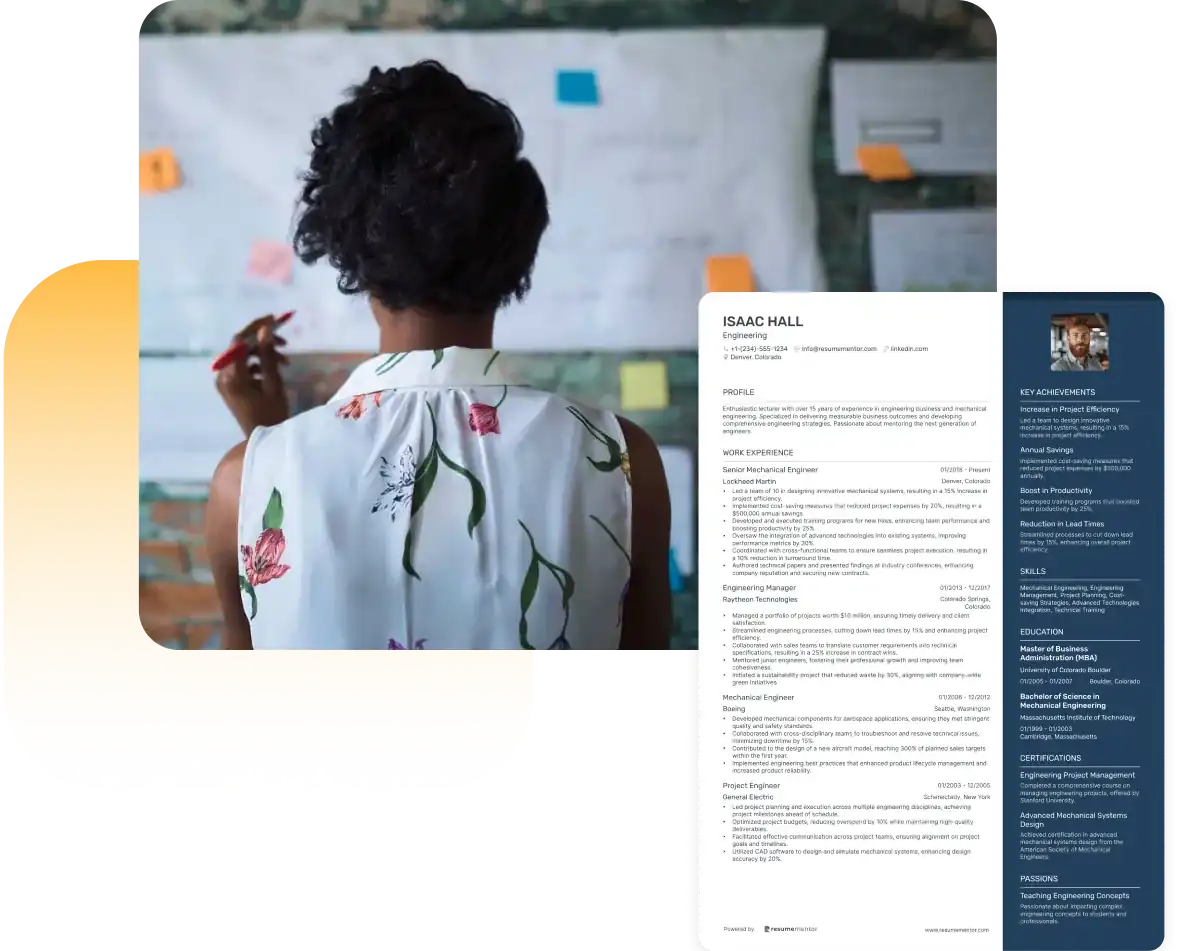
Continue Reading
Check more recommended readings to get the job of your dreams.
Resume
Resources
Tools
© 2025. All rights reserved.
Made with love by people who care.

